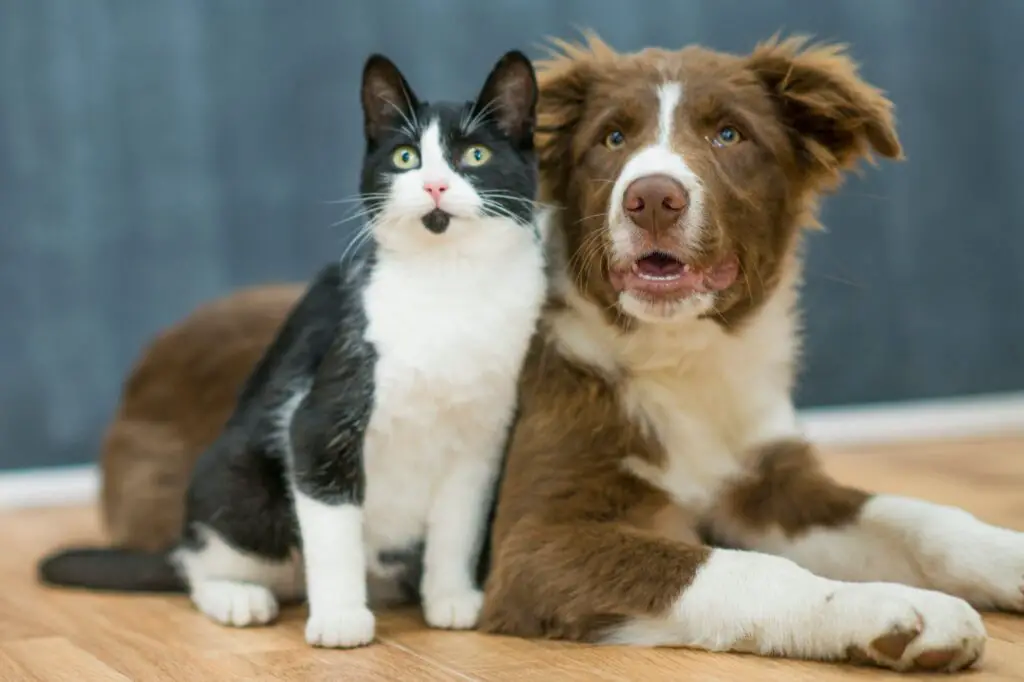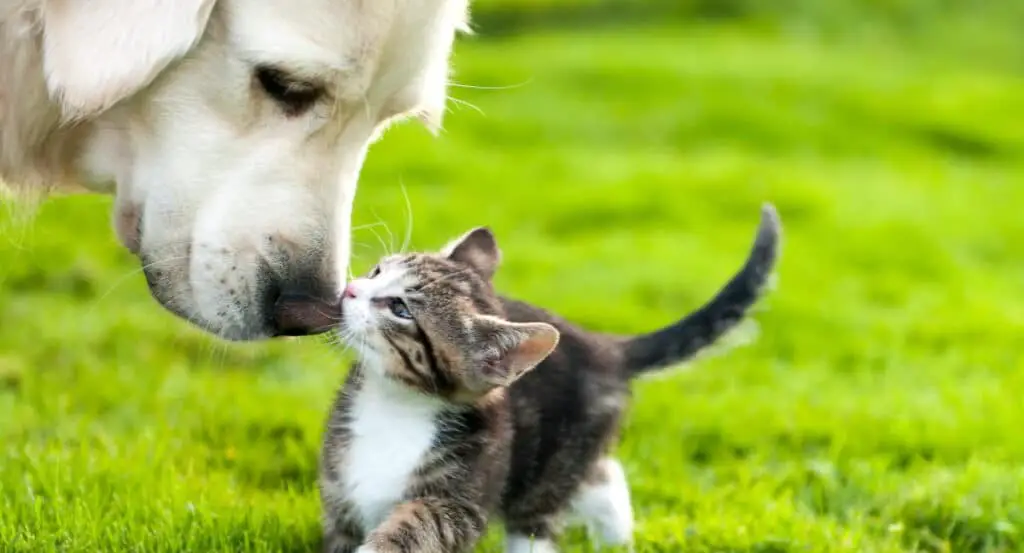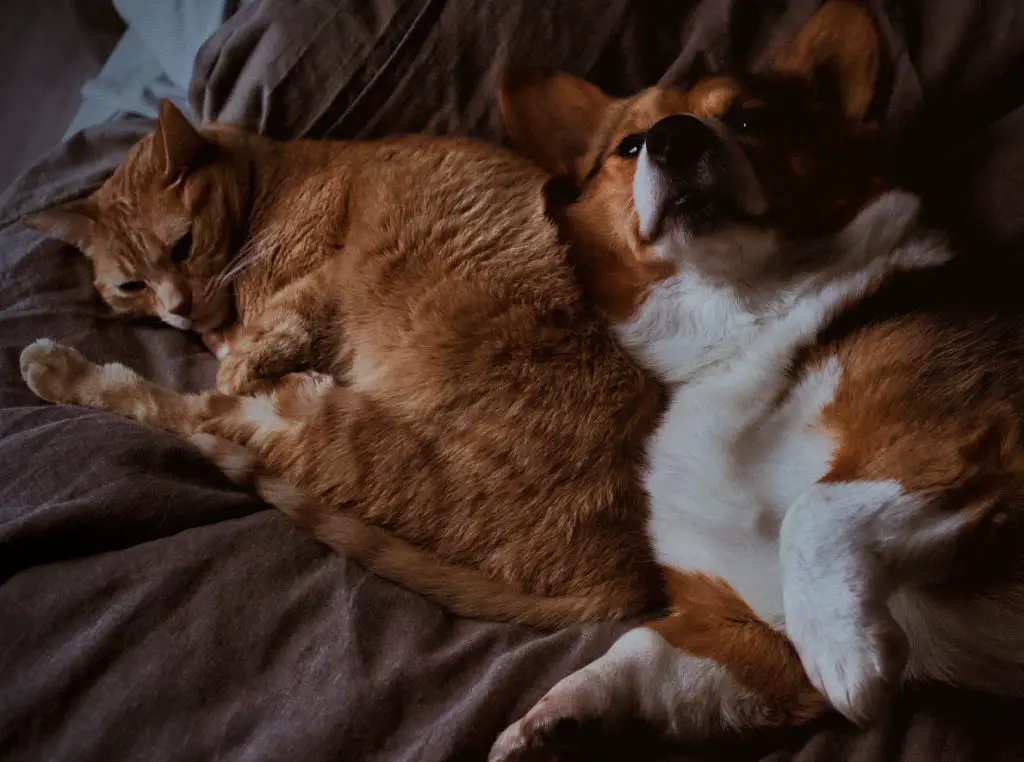Introduction
How To Get A Dog And Cat To Get Along: Bringing a new pet into your home can be an exciting and joyful experience. However, if you already have a dog and are considering getting a cat, or vice versa, you may be wondering how to ensure that they will get along. Dogs and cats are known to have a reputation for being natural enemies, but with the right approach and some patience, it is possible for them to coexist peacefully and even become the best of friends.
Before diving into the strategies for getting a dog and cat to get along, it is important to understand the fundamental differences in their behavior and instincts. Dogs Behaviour are pack animals and are generally more social and eager to please their owners. On the other hand, cats are solitary creatures and tend to be more independent and territorial. These differences can sometimes lead to conflicts between the two species.
When introducing a new pet into your home, it is crucial to take things slow and allow them to adjust to each other’s presence gradually. Start by keeping them in separate rooms and allow them to sniff each other’s scent through a closed door. This will help them become familiar with each other’s presence without feeling threatened. After a few days, you can begin to swap their bedding or toys, so they can become accustomed to each other’s scent.

How long does it take for a cat to get used to a dog?
Introducing a dog and cat may take a couple of weeks to a few months, depending on your individual pets. Always monitor your pets for signs of fear, anxiety, or stress, and progress at a rate they are comfortable with. A positive reinforcement-based trainer can help you introduce the pets if you’re feeling overwhelmed.
Introducing a new pet into your home can be an exciting but also challenging experience. If you already have a cat and are considering getting a dog, one of the most common questions that may come to mind is how long it will take for your cat to get used to the new addition. While every cat is different and there is no set timeframe, there are several factors that can influence the adjustment period.
Firstly, it is important to consider the individual personalities of both your cat and the dog. Some cats are naturally more sociable and adaptable, while others may be more reserved or territorial. Similarly, some dogs may have a calm and gentle demeanor, while others may be more energetic or assertive. These personality traits can greatly impact how quickly your cat and dog will become comfortable with each other.
Secondly, the age and previous experiences of your cat and dog can also play a role in the adjustment period. If your cat has never been exposed to dogs before, it may take longer for them to feel at ease. Similarly, if your dog has had negative experiences with cats in the past, they may be more cautious or wary around your cat. However, if both your cat and dog have had positive interactions with each other’s species before, this can help facilitate a smoother transition.
Thirdly, the introduction process itself can greatly impact how long it takes for your cat to get used to the dog. It is important to introduce them gradually and in a controlled manner. This can involve keeping them in separate rooms initially and gradually allowing supervised interactions. Providing each pet with their own safe space and resources, such as separate feeding areas and litter boxes, can also help reduce any potential conflicts or stress.
Lastly, it is important to be patient and understanding during this adjustment period. Some cats may take only a few days to get used to a new dog, while others may take several weeks or even months. It is important to allow them to set their own pace and not force interactions. Providing positive reinforcement, such as treats and praise, when they display calm and relaxed behavior around each other can also help reinforce positive associations.
Will my cat and dog eventually get along?
Cat-dog relationships can take weeks to fully develop. Whether it’s new to the household or a longtime family member, a cat needs access to a dog-free sanctuary before they ever meet. Cat-dog relationships can take weeks to fully develop, which makes it a good idea to give your cat a safe place of their own.
Introducing a new pet into your household can be an exciting but also challenging experience. If you already have a cat and are considering getting a dog, or vice versa, you may be wondering if your pets will eventually get along. While every situation is unique and there are no guarantees, it is possible for cats and dogs to develop a harmonious relationship over time.
It is important to remember that cats and dogs have different social structures and communication styles. Cats are typically more independent and territorial, while dogs are often more social and pack-oriented. These differences can sometimes lead to conflicts and misunderstandings between the two species. However, with patience, proper introductions, and consistent training, it is possible for cats and dogs to coexist peacefully.
When introducing a new pet into your household, it is crucial to take things slow and allow both animals to adjust at their own pace. Start by keeping them in separate areas of the house and gradually allow them to interact under controlled circumstances. This can be done by using baby gates or crates to create physical barriers while still allowing visual and olfactory contact.
Additionally, it is important to provide each pet with their own safe space and resources. Cats should have access to high perches, hiding spots, and litter boxes that are out of reach of the dog. Dogs should have their own bed, toys, and feeding area. This will help prevent resource guarding and reduce potential conflicts.
Positive reinforcement training can also play a crucial role in helping cats and dogs get along. Rewarding desired behaviors, such as calm and friendly interactions, can help create positive associations between the two animals. It is important to supervise their interactions and intervene if any signs of aggression or fear are displayed.
What to do if your cat and dog don’t get along?
Take something that smells of the dog to the cat (or vice versa), such as a blanket or other bedding the pet has slept on. Allow the pet to interact with the object in their own time. You can offer treats to help them associate the scent with something positive.
If your cat and dog don’t get along, it can be a stressful and challenging situation for both you and your pets. It’s important to address this issue as soon as possible to ensure a harmonious and peaceful environment in your home. There are several steps you can take to help your cat and dog build a positive relationship and coexist peacefully.
1. Gradual Introduction: When introducing a new pet to your home, it’s crucial to do so gradually. Start by keeping them in separate rooms and allow them to become familiar with each other’s scents. You can swap their bedding or use a towel to rub on one pet and then place it near the other pet. This will help them get used to each other’s presence without direct contact.
2. Controlled Interactions: Once your pets are comfortable with each other’s scents, you can start allowing them to have controlled interactions. Use a baby gate or a pet barrier to separate them physically while still allowing them to see and smell each other. This will help them get used to each other’s presence without feeling threatened.
3. Positive Reinforcement: Reward your pets with treats, praise, and affection whenever they display calm and friendly behavior towards each other. This will help them associate positive experiences with each other’s presence and encourage them to build a bond.
4. Separate Resources: Ensure that your cat and dog have separate resources such as food bowls, water bowls, litter boxes, and beds. This will prevent any potential conflicts over resources and give each pet their own space.
5. Seek Professional Help: If despite your efforts, your cat and dog continue to have aggressive or fearful interactions, it may be beneficial to seek professional help from a veterinarian or animal behaviorist. They can provide guidance and develop a customized plan to address the specific issues between your pets.
Is it better to get a cat or dog first?
In the most general terms, though, the best strategy would be to adopt first a middle-aged, well-mannered dog who shows little interest in cats, and then a kitten who has been raised in a household with friendly or indifferent dogs around.
Deciding whether to get a cat or a dog as a first pet can be a tough decision. Both cats and dogs have their own unique qualities and characteristics that make them great companions. Ultimately, the choice between getting a cat or a dog first depends on several factors, including your lifestyle, living situation, and personal preferences.
One factor to consider when deciding between a cat or a dog as a first pet is your lifestyle. Cats are generally more independent and require less attention and exercise compared to dogs. They are often content spending time alone and can be left alone for longer periods of time. On the other hand, dogs are social animals that require more attention, exercise, and mental stimulation. They need to be walked regularly and thrive on human interaction. If you have a busy lifestyle or work long hours, a cat may be a better choice as a first pet.
Another factor to consider is your living situation. If you live in an apartment or have limited outdoor space, a cat may be a more suitable pet. Cats are generally more adaptable to smaller living spaces and can be litter trained. Dogs, on the other hand, require more space to run and play. They also need access to outdoor areas for bathroom breaks and exercise. If you have a house with a backyard or live in a rural area, a dog may be a better choice.
Personal preferences also play a role in deciding between a cat or a dog as a first pet. Some people are naturally more inclined towards cats, while others prefer the companionship and loyalty of dogs. Cats are known for their independent nature and can be more low-maintenance compared to dogs. Dogs, on the other hand, are known for their loyalty and can provide a strong sense of companionship and protection. Consider your own preferences and what you are looking for in a pet before making a decision.
How do I get my cat to stop hissing at my dog?
Use a baby gate to allow your cat to separate itself from your dog. If the dog is bothering the cat, then the cat can leap over the gate and ignore the dog rather than scratching or hissing at the dog to get it to go away.
Introducing a new pet into your household can be an exciting and joyful experience. However, it can also be a challenging one, especially if your cat and dog are not getting along. If your cat is hissing at your dog, it is important to address this behavior as soon as possible to ensure a harmonious living environment for all members of your family.
Firstly, it is essential to understand that hissing is a natural defensive behavior for cats. It is their way of expressing fear, anxiety, or discomfort. Therefore, it is crucial to create a safe and secure environment for your cat to help alleviate these negative emotions. Provide your cat with a designated space where they can retreat to when they feel overwhelmed or threatened. This could be a separate room or a cozy corner with their bed, toys, and litter box.
Secondly, gradual introductions are key when it comes to helping your cat and dog get along. Start by allowing them to sniff each other’s scents without direct contact. Swap bedding or toys between them so they can become familiar with each other’s smells. Once they seem comfortable with this, you can proceed to supervised face-to-face introductions. Keep your dog on a leash and allow your cat to approach at their own pace. Reward both pets with treats and praise for calm and positive behavior.
Additionally, it is important to provide plenty of positive reinforcement and rewards for your cat when they display calm behavior around your dog. This could be in the form of treats, praise, or playtime. By associating positive experiences with your dog’s presence, your cat will gradually learn to feel more comfortable and less threatened.
Furthermore, consider using pheromone diffusers or sprays specifically designed for cats to help create a calming environment. These products release synthetic pheromones that mimic the natural ones produced by cats when they feel safe and secure. They can help reduce stress and anxiety in your cat, making it easier for them to adjust to the presence of your dog.
Introducing a dog and cat to each other requires careful planning and gradual introductions to ensure a positive outcome. One strategy is to start by keeping the dog and cat in separate rooms, allowing them to become familiar with each other’s scents through scent swapping. This can be done by swapping bedding or using a cloth to rub each animal and then placing it in the other’s space.
Once they are comfortable with each other’s scents, you can start with controlled visual introductions. This can be done by using a baby gate or a crate to separate them while allowing them to see each other. Gradually increase the duration of these visual introductions while monitoring their behavior for signs of stress or aggression.
After several successful visual introductions, you can move on to supervised face-to-face interactions. Keep the initial meetings short and positive, rewarding both animals for calm and friendly behavior. Gradually increase the duration of these interactions while closely monitoring their body language and intervening if any signs of aggression or fear arise.
Are there any specific breeds or temperaments of dogs and cats that tend to get along better with each other?
When it comes to introducing a dog and cat to each other, breed and temperament can play a role in their compatibility. While there are no guarantees, certain breeds and temperaments tend to have a higher likelihood of getting along well.
Dogs: Some dog breeds that are known to have a generally friendly and tolerant nature towards cats include Golden Retrievers, Labrador Retrievers, and Beagles. These breeds are often more laid-back and less likely to exhibit aggressive behavior towards cats. Additionally, dogs with a lower prey drive, such as those bred for companionship rather than hunting, may be more inclined to get along with cats.
Cats: Similarly, certain cat breeds are known for their sociability and ability to get along with other animals. Breeds such as Ragdolls, Maine Coons, and Abyssinians are often described as being more dog-friendly. These breeds tend to have a more relaxed and easygoing temperament, making them more likely to accept and even enjoy the company of a dog.
What are some signs that indicate a dog and cat are starting to develop a positive relationship and are getting along well?
When a dog and cat are starting to develop a positive relationship and getting along well, there are several signs to look out for. One of the most obvious signs is when they begin to interact and play with each other. This can include chasing each other, wrestling, or engaging in gentle play behaviors. It’s important to note that play between a dog and cat should always be supervised to ensure it remains positive and doesn’t escalate into aggression.
Another sign of a positive relationship between a dog and cat is when they start to groom each other. This mutual grooming behavior is a sign of trust and affection between the two animals. It’s a way for them to bond and show care for one another. If you notice your dog and cat grooming each other, it’s a good indication that they are comfortable and have developed a positive relationship.
Additionally, a dog and cat that are getting along well will often choose to spend time together. They may choose to nap in close proximity to each other or seek each other out for companionship. This shows that they enjoy each other’s company and feel safe and relaxed in each other’s presence. It’s important to provide separate spaces and resources for each pet to ensure they have their own personal space, but if they voluntarily choose to spend time together, it’s a positive sign of their relationship.
Are there any training techniques or exercises that can help foster a harmonious relationship between a dog and cat?
Yes, there are several training techniques and exercises that can help promote a harmonious relationship between a dog and cat. One important technique is to gradually introduce the animals to each other in a controlled and supervised environment. This can be done by allowing them to sniff each other’s scent through a closed door or using a baby gate to separate them initially. Over time, the distance between them can be decreased until they are comfortable being in the same room together.
Another helpful exercise is to provide positive reinforcement for calm and appropriate behavior. This can be done by rewarding both the dog and cat with treats or praise when they are calm and relaxed in each other’s presence. It is important to avoid punishing or scolding either animal during this process, as it can create negative associations and hinder progress.
How can a pet owner address any potential challenges or conflicts that arise between a dog and cat living in the same household?
When challenges or conflicts arise between a dog and cat living in the same household, it is important for the pet owner to take proactive steps to address the situation and promote a harmonious environment. One strategy is to provide each pet with their own separate space, such as a designated room or area, where they can retreat to when they need some alone time. This allows them to have a sense of security and reduces the likelihood of confrontations.
Additionally, it is crucial for the pet owner to establish clear boundaries and rules for both the dog and cat. This can be done through consistent training and reinforcement of desired behaviors. By teaching the pets basic commands and rewarding them for positive interactions, the pet owner can help create a peaceful coexistence.
If conflicts do arise, it is important for the pet owner to intervene and redirect the pets’ attention to more positive activities. This can be done by providing interactive toys or engaging in play sessions with both the dog and cat. By redirecting their focus onto something enjoyable, the pet owner can help diffuse any tension and prevent further conflicts.

Conclusion
Getting a dog and cat to get along requires patience, time, and proper introduction techniques. It is important to remember that each animal has its own unique personality and may require different approaches. By following the steps outlined in this guide, you can increase the chances of a harmonious relationship between your dog and cat.
Firstly, it is crucial to provide a safe and comfortable environment for both animals. This includes creating separate spaces for each pet, such as designated sleeping areas and feeding stations. Additionally, providing plenty of toys, scratching posts, and hiding spots can help alleviate any potential territorial issues.
Secondly, gradual introductions are key. Start by allowing the pets to become familiar with each other’s scents by swapping bedding or using a pheromone diffuser. Next, introduce them through a barrier, such as a baby gate or a cracked door, allowing them to see and smell each other without direct contact. Slowly increase their interactions over time, always monitoring their behavior and providing positive reinforcement for calm and friendly interactions.
Lastly, it is important to address any signs of aggression or fear immediately. If either the dog or cat displays aggressive behavior, separate them and consult with a professional trainer or behaviorist. They can provide guidance on how to manage and modify the behavior to ensure the safety and well-being of both pets.
While it may take time and effort, it is possible for a dog and cat to get along. By providing a safe environment, introducing them gradually, and addressing any issues promptly, you can foster a positive and peaceful relationship between your furry friends. Remember to be patient and understanding, as each animal may require different approaches. With dedication and love, your dog and cat can become the best of friends.





No Comments